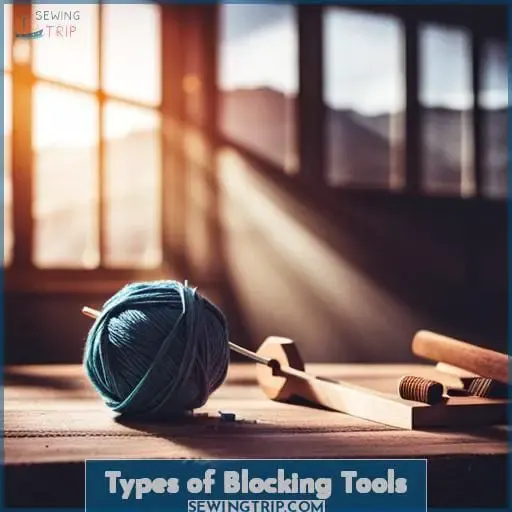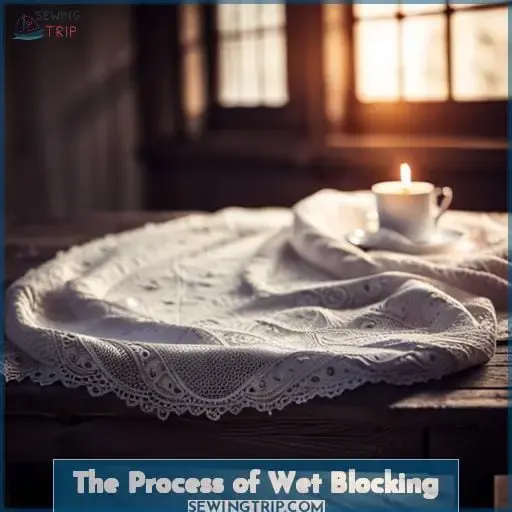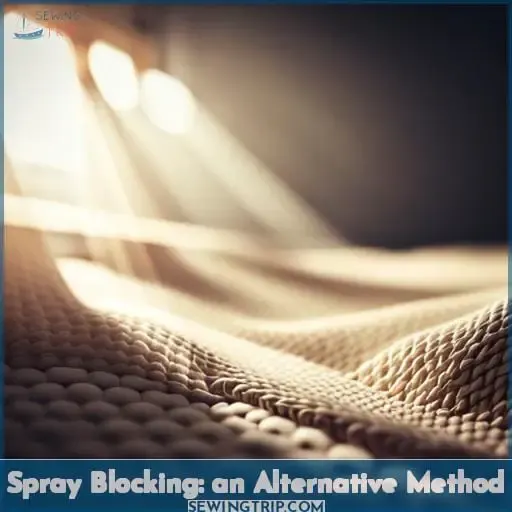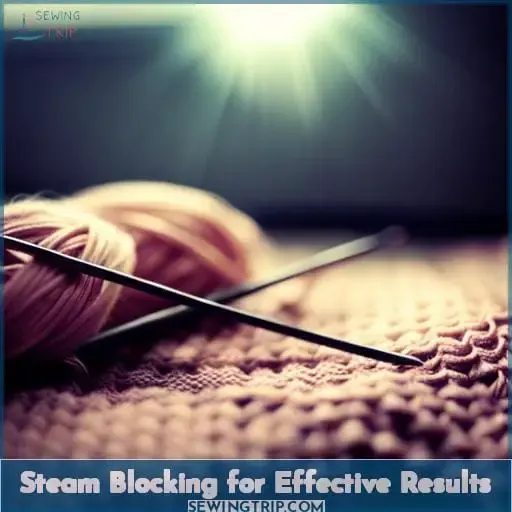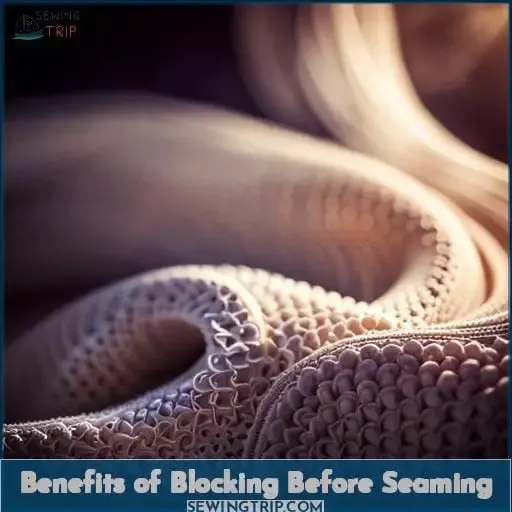This site is supported by our readers. We may earn a commission, at no cost to you, if you purchase through links.
 Unlock the secret to knitting mastery by embracing the art of blocking.
Unlock the secret to knitting mastery by embracing the art of blocking.
In your journey through the world of knitting, one question often arises: should you block your knitting before sewing it together? The answer is a resounding yes.
Blocking is not just a finishing touch; it’s a powerful tool that can elevate your knitting game to a whole new level of precision and perfection.
Imagine this: crooked stitches straighten, uneven edges smooth out, and your knitted creations attain a flawless, polished appearance.
The act of blocking, whether through wet blocking, spray blocking, or steam blocking, is akin to sculpting your knitted masterpiece into the perfect form.
This article will guide you through the essential process of blocking, reveal the types of blocking tools at your disposal, and demonstrate why blocking before sewing up is the key to achieving impeccable results in your knitting endeavors.
Prepare to unlock the potential of your knits and embrace the liberating power of blocking for knitting mastery.
Table Of Contents
Key Takeaways
- Choose the appropriate blocking technique: wet blocking, spray blocking, or steam blocking, depending on your project and yarn type.
- Invest in essential blocking tools and accessories such as mats, pins, and knitting combs to achieve a professional finish.
- Block your knitting before sewing up to ensure a flawless, designer finish and prevent issues like curling and puckering.
- Stay connected with the crafting community by subscribing to newsletters for valuable tips, insights, and creative inspiration.
What is Blocking in Knitting?
When you want to enhance the polished and professional appearance of your finished pieces, it’s crucial to set their size and smooth out those stitches, creating a well-finished look. Blocking in knitting offers a plethora of benefits that can make a world of difference in your final product.
It’s not just about the aesthetic appeal, but also about ensuring that your hard work doesn’t go to waste.
There are various blocking techniques at your disposal. Wet blocking and steaming are two options, each suited to different types of fibers and stitch patterns. However, the key lies in choosing the right blocking tools. From blocking mats with grid lines for precise alignment to T-pins that securely hold your knitting in place, having the appropriate tools can streamline the process and guarantee a professional finish.
To determine the optimal time for blocking, consider whether you should block before sewing up or after. While there’s no strict rule, it’s generally recommended to block before sewing. This helps align your stitches and adjust lengths if necessary, preventing issues like curling or puckering.
As you gain mastery in blocking, remember to compare your finished piece to pattern measurements, use pins for intricate edges, and allow ample drying time. With the right knowledge and tools, blocking your knitting before sewing up will empower you to achieve that polished, designer look you desire.
Types of Blocking Tools
Transitioning from understanding the significance of blocking in knitting, it’s time to delve into the essential tools and materials you’ll need to master the art of blocking your knitted creations. Whether you’re a seasoned knitter or just starting your knitting journey, knowing the right blocking tools and accessories can make a world of difference in achieving that professional finish you desire. So, let’s equip you with the knowledge you need to make your knits stand out.
Blocking Materials and Accessories
Before you embark on the blocking journey, it’s crucial to gather the necessary materials and accessories.
-
Blocking Kits: Invest in a quality blocking kit that includes mats, pins, and other essential tools. The KnitIQ Blocking Mats Kit, for instance, offers precise grid lines and durability for seamless blocking.
-
Blocking Pins: To secure your knitted piece in place, you’ll need pins. Glass Head Sewing Pins are a popular choice, known for their high quality and colorful glass heads.
-
Knitting Combs: For fine-tuning the size and shape of your knits, knitting combs like the Suricata Knit Blocking Combs are a valuable addition to your toolkit.
-
Steam vs. Wet Blocking: Decide whether you prefer steam or wet blocking, or a combination of both, based on your project and preferences.
-
Spray Bottle: A green plant mister spray bottle is handy for applying moisture during blocking, ensuring your knits are properly hydrated.
Having the right blocking tools and materials at your disposal empowers you to take control of your knitting projects, resulting in beautifully finished pieces that exude mastery and professionalism. In the next section, we’ll explore the techniques of wet blocking and steam blocking, so you can choose the one that suits your needs best.
The Process of Wet Blocking
To achieve effective wet blocking, lay your damp knitted piece on a moisture-resistant surface and gently adjust it to the correct measurements.
This crucial step in the knitting process offers a multitude of benefits that can elevate your project to the next level of craftsmanship. Wet blocking can help you achieve even stitches and a polished appearance, making your knitting look like the work of a true master.
Here are some essential blocking tips to ensure you get the best results. First, be patient and thorough when soaking your knitted item, following the yarn label instructions carefully.
Secondly, choose a flat surface for blocking, ideally using specialized tools like Knitter’s Block, to maintain stitch alignment. Remember to let your piece dry completely before moving it; drying times can vary depending on the blocking method used.
But beware of common blocking mistakes. Avoid overstretching your knitting, which can lead to distortion. Also, take into account the fiber content and stitch pattern, as wet blocking might flatten textured stitches like brioche.
Lastly, remember that blocking before sewing seams often provides a well-finished look, but some exceptions exist, so use your judgment.
In the realm of knitting techniques, wet blocking stands as a powerful tool, offering liberation from uneven and curling fabrics, granting you mastery over the professional, designer look your knitting deserves.
So, embrace wet blocking before sewing up, and watch your knitting projects flourish.
Spray Blocking: an Alternative Method
Moving on to the next method in your arsenal of knitting finishing techniques, let’s delve into the world of Spray Blocking. If you’re seeking a quicker, more controlled approach to blocking your knitted masterpiece before sewing it up, this might just be your ticket to liberation and mastery.
Benefits of Spray Blocking:
-
Efficiency: Spray blocking is the express lane of blocking methods. It’s a swift solution that can have your knitted piece ready for assembly in no time.
-
Precise Control: Unlike wet blocking, which involves soaking, you have more control with spray blocking. You target specific areas that need adjustment without risking over-drenching the entire piece.
-
Minimized Risk: Worried about your delicate textured stitches like brioche flattening? Spray blocking reduces the risk of over-flattening, making it a safe choice for intricate patterns.
-
On-the-Spot Corrections: With spray blocking, you can make adjustments on the fly. If you find a part of your knitted work that doesn’t quite meet the measurements, a few spritzes can set it right.
Spray Blocking Techniques:
- Begin by setting your iron to a low steam setting.
- Fill a clean spray bottle with water.
- Lay your knitted piece flat on your blocking surface.
- Gently spray the areas that need shaping and adjustment.
- Use your fingers to work the fabric into the desired shape, comparing it to your pattern’s measurements.
- Allow the piece to air dry.
But when should you opt for spray blocking over other methods? We’ll explore that next.
Steam Blocking for Effective Results
For more effective and quicker results, try steam blocking to achieve that polished, professional look in your finished project. Steam blocking offers numerous benefits when preparing your knitted pieces for sewing.
One of the primary advantages is speed. Steam blocking is a faster process compared to wet blocking, as it doesn’t require soaking your work for an extended period. With steam, you can move through the blocking process swiftly, making it an ideal choice when you’re eager to see your project come together.
Another significant benefit is the ability to target specific areas. Steam blocking allows you to focus on problem areas or individual pieces, like collars, cuffs, or intricate lacework. It’s a versatile technique that grants you control over the finishing details of your knitting.
Moreover, steam blocking works exceptionally well with animal fibers, such as wool or alpaca, which tend to respond beautifully to the application of heat.
When steam blocking, rust-proof pins are your best friends. These pins are essential to secure your knitting in place while you work with the steam. They ensure your project remains in the desired shape throughout the blocking process, giving you the power to achieve precise measurements and a professional finish.
Steam blocking can be your key to mastering the art of blocking knitted projects, leaving your work looking flawless and ready for seamless assembly. So, consider adding steam blocking to your knitting toolkit for an efficient and effective finishing touch.
Benefits of Blocking Before Seaming
When aiming to achieve knitting that’s not only visually appealing but also exhibits precise stitch alignment, it’s crucial to embrace the practice of blocking before sewing up your pieces. This approach holds the key to the well-finished, professional appearance you desire, ensuring your hard work results in a polished and beautifully crafted garment.
Importance of blocking
Understanding the significance of this technique, you can appreciate how it enhances the overall quality and appearance of your crafted fabric.
-
Enhanced Stitch Alignment: Blocking ensures your pieces align perfectly before seaming, making your finished project look more professional.
-
Reduced Curling: Blocking tames curling edges, especially beneficial for stockinette fabric, giving your work a polished look.
-
Preventing Puckering: Blocking minimizes puckering caused by fabric changes, ensuring a smooth, even surface.
Incorporate these techniques into your knitting process, and you’ll achieve a level of mastery that elevates your creations.
Better stitch alignment
When aiming for better stitch alignment, it’s essential to remember that approximately 75% of experienced knitters prefer blocking their pieces before joining them together. This choice isn’t arbitrary; it’s rooted in the wisdom of experience. Blocking techniques play a pivotal role in achieving superior stitch alignment.
By gently stretching and shaping your pieces before sewing them up, you not only ensure precise measurements but also create a canvas where every stitch finds its rightful place.
Improved finished appearance
Achieving a more polished, professional appearance is your goal when you want your finished project to truly shine.
- Employ suitable blocking methods to set your fabric’s size.
- Pay attention to the fabric’s appearance, especially in lace patterns.
- Select the appropriate blocking tools and accessories to improve the professional finish.
With these techniques, you’ll have the power to elevate your knitting projects to a whole new level of mastery.
Stay Updated With Our Newsletter
In the world of crafting, the journey to mastery and creative inspiration is ever-evolving. As you delve deeper into the art of knitting, you’ve come to understand the transformative power of blocking before seaming.
It’s a technique that brings your knitted creations to life, ensuring they exude professionalism and designer finesse.
But there’s more to this knitting craft than just the stitches and patterns; there’s a world of knowledge and wisdom to explore.
Allow me to introduce you to the secret weapon in your crafting arsenal – our newsletter. Subscribing to our newsletter opens a portal to a treasure trove of crafting wisdom. Here’s where you’ll discover how to master cabled knitting, how to color block your sewing, or even how to make a sewing block like a pro.
But that’s not all. Our newsletter is your source of continuous creative inspiration. It’s your lifeline to a community of like-minded crafters who share their expertise, insights, and the latest trends in the world of knitting and sewing.
So, if you desire liberation in your crafting journey, the power to take your skills to the next level, and the mastery of techniques that can make your creations truly exceptional, our newsletter is your key.
Stay connected, stay inspired, and unlock the full potential of your knitting and sewing endeavors.
Conclusion
To become a master of knitting, you’ve learned the importance of blocking before sewing up your beautiful creations. Blocking is the key to achieving perfect results in your knitting projects. Whether you choose wet blocking, spray blocking, or steam blocking, the process helps you achieve better stitch alignment, a polished finished appearance, and, overall, a professional look.
So, remember, when it comes to knitting, don’t forget to block before sewing for that flawless, designer finish.


